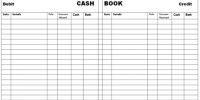Closing entry are journal entry made at the end of an accounting cycle to set the balance of temporary accounts to zero to begin the next accounting period. The temporary accounts that are closed are revenue, expense, and drawing accounts. The assets, liabilities, and owner’s equity accounts are not closed. They are permanent account and their ending balances are the beginning balances for the next accounting period.
There are four basic steps to closing the books-
- Closing the revenue accounts— transferring the balances in the revenue accounts to a clearing account called Income Summary.
- Closing the expense accounts— transferring the balances in the expense accounts to a clearing account called Income Summary.
- Closing the Income Summary account— transferring the balance of the Income Summary account to the Retained Earnings account (also known as the capital account).
- Closing the Dividends account— transferring the balance of the Dividends account to the Retained Earnings Account.















